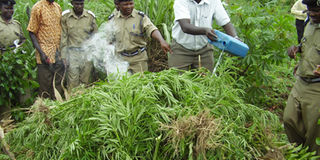How big is Uganda’s drug problem?

DANGEROUS: Police burn heaps of marijuana plants during one of their crackdown on Ugandans who grow the banned weed.
Kampala
It was one of those shocking news items. A Ugandan lady had been arrested at Jomo Kenyatta International Airport with 21kilogrammes of cocaine whose street value was worth Shs2.2 billon. That wasn’t all. Ms Anne Birungi Bisaso was not who she claimed she was. She, according to the chief of the joint security operations at Entebbe Airport, was actually Ms Gillian Kiconco and was on the police wanted list. This lady’s woes posed some serious questions. Where was she taking the drugs? Is there a drug problem in Uganda? And how did Ms Kiconco became Ms Bisaso?
When you look at her itinerary on that fateful day, it kicked off from Brazil, through South Africa en-route to Uganda. How did she manage to invade the airport security of all these countries especially South Africa, where with the World Cup going on, one would think cocaine would be the last item to go past the security there?
Ms Bisaso’s case is just a small part of the big problem Uganda is facing with drugs.
According to the Ugandan ambassador to China, Mr Charles Madibo Wagidoso by 2008, 35 Ugandans were languishing in Chinese prisons. 18 of them women. Twenty of the 35 had their sentences reduced from death to life imprisonment. It’s that bad.
So, are Ugandans sniffing and injecting themselves with “crack”, as narcotic drugs are popularly known? “No not all. The number that takes that hard stuff is small,” says Mr Yusuf Katamba, the head of narcotics operations of Uganda Police. According to him, heroin and cocaine are too expensive to be available on a local market. “For one to use such hard drugs, you have to have much money on you. That is why the number that uses it in Uganda is negligible and does not pose such a serious threat,” he said.
So what is Ms Bisaso and recently Mr John Mugisha who was arrested doing with kilos of cocaine? “Uganda is a transit country for drug traffickers,” says Mr Katamba. “The people behind this trade are West Africans, Asians and Europeans. What they do is to use our country and others to transport their cocaine to markets in Europe. They know that our airport security is weak so they take that advantage,” Mr Katumba says. Africa especially West Africa is emerging as transit hub for south American narcotics gangs. Recently in Gambia, the police with the help of Britain’s Serious Organised Crime Agency achieved one of the biggest narcotics seizures in West Africa’s history, discovering cocaine worth Shs3 trillion.
Locally produced
The drugs were discovered in an underground bunker in a fishing warehouse outside Banjul, Gambia’s capital. Together with the cocaine, loaded weapons and Shs506 million was also discovered.
The United Nations Office on Drugs and Crime estimates that of the 660 tonnes of cocaine produced in Columbia, Bolivia and Peru last year, about 30 to 100 tonnes were trafficked through West Africa.
This trafficking involves high-placed government sources. In Guinea, Captain Ousmane Conte, the son of the late dictator Lansana Conte admitted on national television last year to being part of a cocaine trafficking ring. The ring consisted the country’s judges, police heads and family members of the First Family.
In Uganda too, those in power have been implicated. Media reports have pointed to army generals to be behind the cocaine trafficking. But Mr Katumba insists cocaine is not the problem. It is cannabis. “It is locally produced here and it is cheap. We really have a big problem. The media have focused on “big stories” of cocaine smuggling but we destroying farms of marijuana and cannabis daily in Wakiso, Mpigi, Luwero, everywhere,” Mr Katumba said.
Mr Katumba says the problem is rather severe as school children are using cannabis too. “They see people like Sean Paul, Beanie Man smoking that stuff on stage and they think its “cool” to do the same,” he said.
Weak laws
He also laments about the weakness in the National Drug Authority Act, which law, he says, contains laughable penalties for cannabis users.
“It fines them very little money! I am yet to see someone being sentenced to many years for drug abuse,” he says.
Even as Mr Bisaso’s case brought to the forefront the drug problem in Uganda, it also highlighted how porous our immigration system is. How could a wanted person whose passport was confiscated, mange to get a new passport and then evade the airport security on her journey to traffic drugs?
According to the immigration office, Ms Bisaso had actually obtained three passports. How did she do it? “We don’t have the biometric software to track down false identities,” says Ms Eunice Kisembo, the spokesperson of the Immigration Department.
Biometrics technology authenticates peoples’ identity by using the uniqueness of a person’s biological and behavioural characteristics like fingerprint reader, blood vessels in the eyes, voice or shape of the face. The lack of biometric software is a severe handicap for the immigration department and points to how rudimentary the department is.
Coupled with the lack of technology is the seemingly haphazard coordination between the airport police and the immigration office. According to Ms Kisembo, the police that first arrested the woman in 2007 and confiscated her passport did not inform them about the events. “Since we didn’t have the information from police she was able to evade the process and acquire a new passport.” According to the United Nations Office on Drugs and Crime report of 2007, Uganda is named as a rising transit country for drug traffickers.



